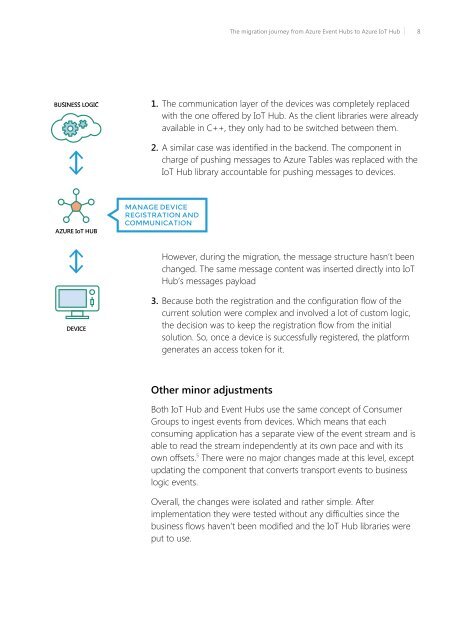JOURNEY FROM AZURE EVENT HUBS TO AZURE IOT HUB
IoT-iQuest-Whitepaper
IoT-iQuest-Whitepaper
Create successful ePaper yourself
Turn your PDF publications into a flip-book with our unique Google optimized e-Paper software.
The migration journey from Azure Event Hubs to Azure IoT Hub 8<br />
1. The communication layer of the devices was completely replaced<br />
with the one offered by IoT Hub. As the client libraries were already<br />
available in C++, they only had to be switched between them.<br />
2. A similar case was identified in the backend. The component in<br />
charge of pushing messages to Azure Tables was replaced with the<br />
IoT Hub library accountable for pushing messages to devices.<br />
However, during the migration, the message structure hasn’t been<br />
changed. The same message content was inserted directly into IoT<br />
Hub’s messages payload<br />
3. Because both the registration and the configuration flow of the<br />
current solution were complex and involved a lot of custom logic,<br />
the decision was to keep the registration flow from the initial<br />
solution. So, once a device is successfully registered, the platform<br />
generates an access token for it.<br />
Other minor adjustments<br />
Both IoT Hub and Event Hubs use the same concept of Consumer<br />
Groups to ingest events from devices. Which means that each<br />
consuming application has a separate view of the event stream and is<br />
able to read the stream independently at its own pace and with its<br />
own offsets. 5 There were no major changes made at this level, except<br />
updating the component that converts transport events to business<br />
logic events.<br />
Overall, the changes were isolated and rather simple. After<br />
implementation they were tested without any difficulties since the<br />
business flows haven’t been modified and the IoT Hub libraries were<br />
put to use.


